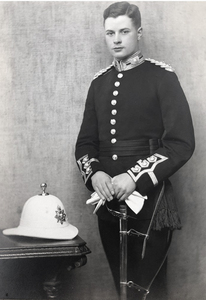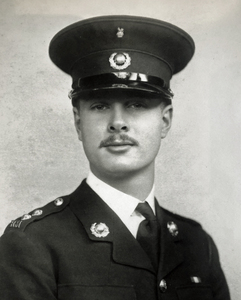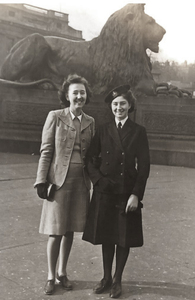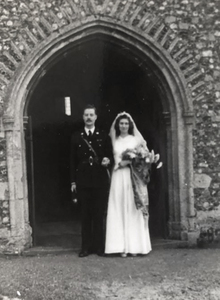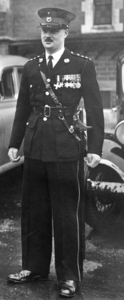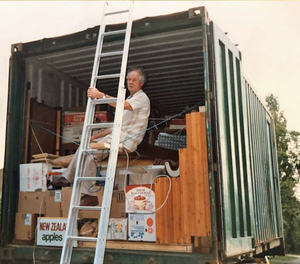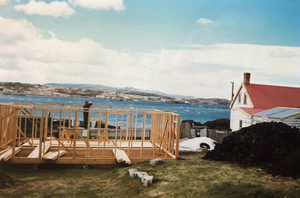TOASE, AIDAN EDWARD
1918-2009 from England
Captain Royal Marines; DSC, was born on15 July 1918 in Halifax, West Yorkshire. He was the eldest son of Canon Edward J Toase, MA; (1889-1965) Rector of Ashill, near Swaffham, Norfolk and of his mother Ruth née Paris. (1890-1972)
He joined the Royal Marines as a young man in February 1937 and was commissioned as a Second Lieutenant. In December 1939 he was serving in HMS Exeter at the time of the Battle of the River Plate. As the result of his actions on 13 December 1939, Toase was awarded the Distinguished Service Cross. (Aidan Toase's brother - Andrew William Toase - joined the Royal Marines in 1940; he also rose to the rank of Captain and was Mentioned in Despatches in 1952. He died in 2008).
In September 2005 Toase contributed to the BBC Oral History Project and described the part he played in naval battle off the coast of South America. In a typically self-deprecating manner, he gives a vivid eyewitness account of the battle and its aftermath:
‘On the morning of 13 December 1939, I was keeping the morning watch in the after-control position. My particular job was to keep the lookouts awake and doing their job. It is all too easy to go to sleep sitting on a comfortable seat and leaning against a bracket holding a powerful set of Admiralty binoculars. I was a junior lieutenant in the Royal Marines and was second in command of the Royal Marine Detachment.
Humphrey Woods was the Captain of Marines and at action stations he was in charge of B turret manned by the R.M. Detachment …The Marines manned B turret. I had tried to get charge of the turret myself a few weeks earlier as it would be more interesting than chasing lookouts. But Captain Woods was not having any of it and I had to remain with my lookouts.
At about 0600 the Graf Spee was sighted well down on the horizon and the bugler sounded Action Stations …I well remember my heart went well down into my boots as everyone was hurrying to his position. Very soon two great clouds of fire and smoke burst from the enemy as he fired his first broadside and about a minute later a line of shells landed in the sea about 300 yards short. Our course was set to get within range of the enemy and return fire. The next enemy broadside was correct for range but fell about 300 yards astern. Thereafter we were receiving our punishment but managed to get within gun range of the Graf Spee and scored several hits. B turret was hit by an 11-inch shell between the guns after firing about 5 broadsides, and everyone in front of the breeches was killed including Captain Woods. Splinters from this shell killed several people on the bridge and cut all communications so Captain BELL (the ship's Captain) came aft to fight the ship from the after-control position. Very soon both A and Y turrets were [also] put out of action because their electrical supplies were cut off, so Captain Bell said within my hearing “I'm going to ram the Graf Spee. It will be the end of us - but it will sink him too”. So off we set. Fortunately, the electricians managed to get Y turret working again so we turned away and carried on firing with Y turret. Normal steering of the ship was not possible due to damage, so we organised a chain of seamen to pass steering orders down to the after steering position.Lookouts were no longer required so I went to look at B turret. There was some burning debris on top of one gun loading tray and immediately under it a naked charge ready for loading into the gun. It looked a nasty situation, so I removed the charge by chucking it overboard and put out the fire.
While we were getting our punishment Commodore HARWOOD in the Ajax and the Achilles were scoring hits on the Graf Spee from the disengaged side. It was clear that the Graf Spee was trying to get into Montevideo, so Commodore Harwood signalled us to report the state of the ship and then ordered us to go back to Stanley in the Falkland Islands. Ajax and Achilles followed the Graf Spee until she was interned in Montevideo and waited outside for reinforcements in case she tried to get away. That evening we buried about 50 of the ships company at sea. On 17th December, the Graf Spee sailed out of Montevideo and scuttled herself, thus saving many lives. I well remember our reception in Stanley. Nothing was too much for people to do for us. It took about six weeks to get the ship seaworthy.’
Aidan Toase’s time in the Falklands had a significant personal outcome for him, he goes on to say:
‘I had a very happy time there as I made the acquaintance of a young girl called Cora NEWING. Whenever I could get ashore, I would seek her out and she would provide a horse and we would go out to the lighthouse or some other beauty spot. She followed me to UK in 1943 arriving the day I was off to the Mediterranean. She joined the Marens (The Royal Marines branch of the Wrens) and had an interesting time. My [next] ship was HMS Abercrombie a monitor with one 15-inch gun turret. I was now the Captain of Marines and manning this turret was our job. We took part in the invasions of Sicily and Italy … After that I was transferred to the cruiser HMS Aurora for a few months and then sent home in time for Christmas 1944.’
For his actions during the Battle of the River Plate, Aidan Toase was awarded the DSC in February 1940. His citation reads: ‘He was very active and resourceful in assisting to render turret safe after it was hit by an11inch shell – in recognition of the gallant and successful action with Admiral Graf Spee’
In December 1944 Aidan Toase met up with Cora Newing for the first time after a five-year break. Cora Agnes Newing, born 1922 in Stanley, was the only daughter of Albert Newing and Dorothy Newing (née Aldridge) of Stanley. The couple were married by Special Licence on 30 December 1944, at Ashill parish church, near Swaffham, by Aidan’s father, one week after he returned home.
After leaving the Falklands in 1943 Cora Toase never saw her parents again.
The married couple had little time together because in March 1945 Aidan Toase joined the 27 Battalion of Royal Marines in Holland chasing the Germans all the way up to Wilhelmshaven. For his actions during this part of the war he was ‘Mentioned in Despatches’, in January 1946, and his citation read: ‘for his gallant and distinguished services in Western Europe.’
Aidan Toase eventually left the Royal Marines in June 1958 with the rank of Captain, and he trained as a teacher. The family settled in Chichester and he taught maths at Chichester College until he retired in 1978. The couple had three children (two boys and a girl), and the family had a series of sailing boats in Chichester harbour which they all enjoyed.
The events of the 1982 Conflict stirred a longing in the Toases to return and see what they could do to help and support the Falklands community. They went out to the Falklands in1983 with the idea of helping set up local industries and to teach weaving. Cora Toase was an expert spinner and weaver (having been taught to weave by her mother) They left RAF Brize Norton for Ascension and were then helicoptered onto HMS Uganda for a 10-day sail to Stanley.
The Toases took with them sufficient wood to make looms, all of which were designed and built by Aidan. They joined the spinners guild and they met to plan the future. The Guild met in the Old Gym, and the weaving project began, with Aidan assembling the looms and arranging the radio coverage of the reopening of the Guild premises. Cora ran weaving classes – the students included the Rector - Harry BAGNALL and his wife Iris.
The Toases stayed 6 months and left the week after the KEMH hospital burned down in April 1984. They went out again to the Falklands in 1986 and they were delighted that the weavers were still weaving, and a business (called ‘Home Industries’) had begun.
Kitty BERTRAND, a great friend of Cora Toase, offered them some land to build a house. On their return to the UK they decided to build their own home in Stanley. Aidan designed the house and drew up the plans. They gathered together all the materials they would need – everything from a cement mixer, to wood, nails, glass for windows, down to bedding and cutlery. Everything was loaded into a container and shipped out.
In 1987 they built their Stanley home themselves even though they were both in their 60s. They did everything - from laying the foundations and drains up to installing the tin roof, usually during high winds. From then on they continued to live half the year in Stanley and the other in Chichester until they were in their 80's.
Aidan was a skilled woodworker - he built the loom that Cora used for weaving. In his 70s he taught himself computer programming, and wrote an astrological programme in order that he might more accurately predict the movement of the stars. Cora and Aidan Toase were committed members of the Cathedral congregation. Aidan restored the cathedral clock and Cora played the organ. When they arrived in Stanley in 1983, after an absence of nearly 40 years, Cora went into the cathedral and found her music with her name ‘Cora Newing’ was still there in the piano stool.
Aidan and Cora Toase celebrated their diamond wedding on 30 Dec 2004. In 2007 they moved to Sheffield to be near their family.
Aidan Toase died on 9 April 2009 in Sheffield, and Cora Toase died in 2018.
See: Images 418 and 484
See: Images 778 and 976
External links
Comments
Revisions
November 2020 Biography first added
